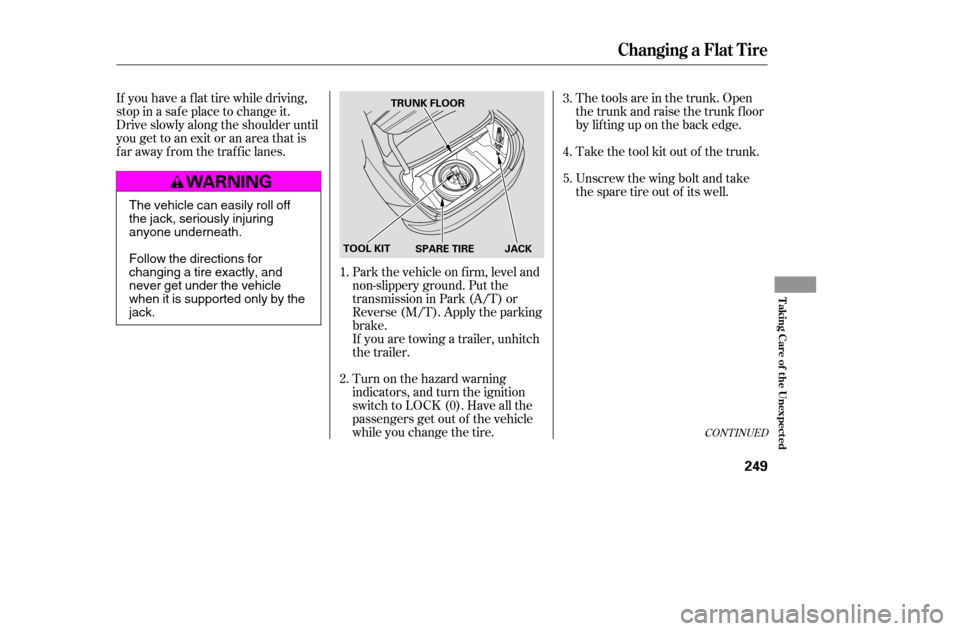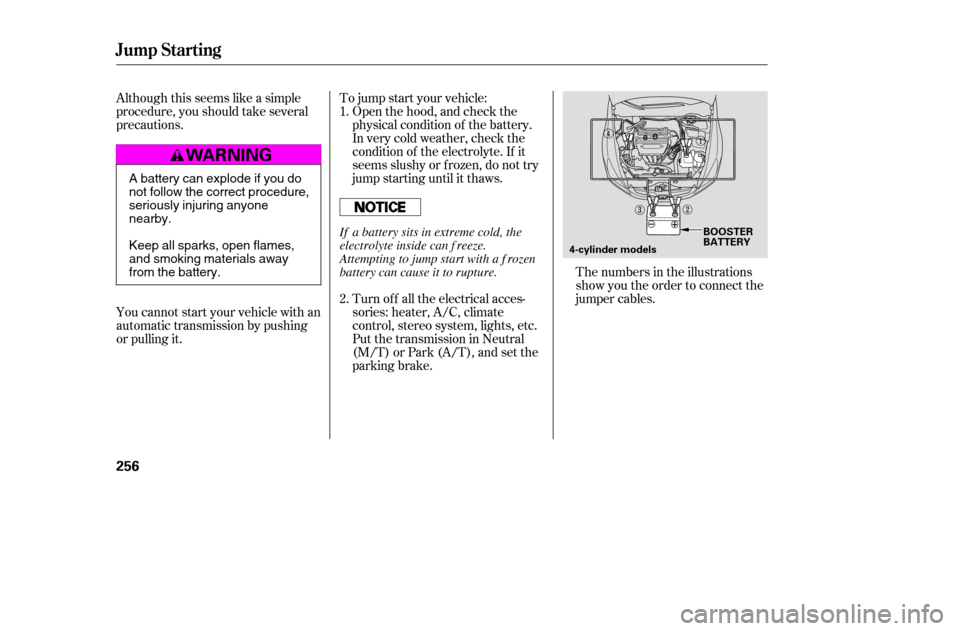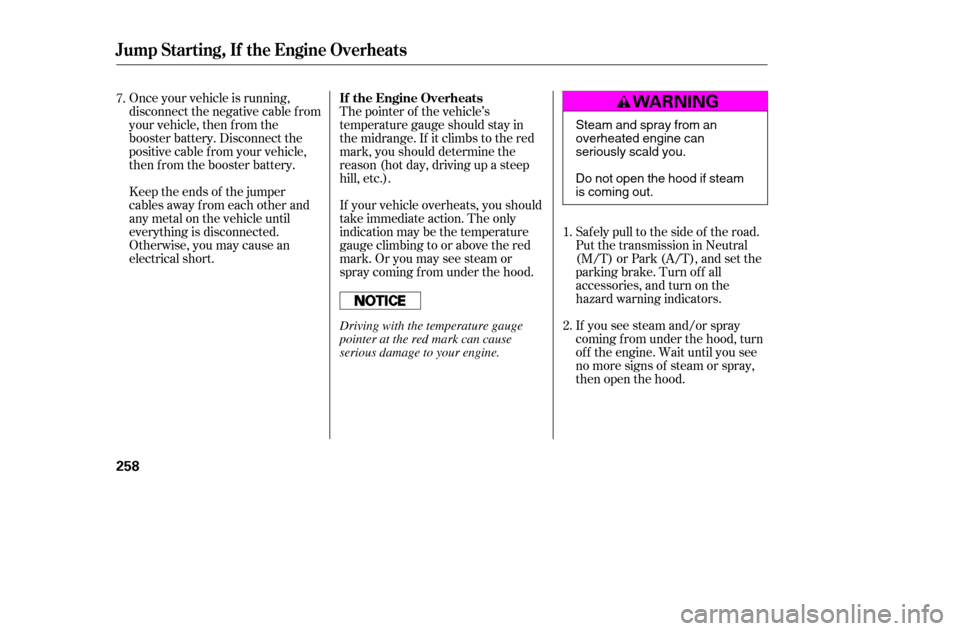Page 240 of 289

CONT INUED
If you have a f lat tire while driving,
stop in a saf e place to change it.
Drive slowly along the shoulder until
you get to an exit or an area that is
far away from the traffic lanes.If you are towing a trailer, unhitch
the trailer.
Turn on the hazard warning
indicators, and turn the ignition
switch to LOCK (0). Have all the
passengers get out of the vehicle
while you change the tire.The tools are in the trunk. Open
the trunk and raise the trunk f loor
by lif ting up on the back edge.
Take the tool kit out of the trunk.
Unscrew the wing bolt and take
the spare tire out of its well.
Park the vehicle on f irm, level and
non-slippery ground. Put the
transmission in Park (A/T) or
Reverse (M/T). Apply the parking
brake. 5.
4.
3.
2. 1.
Changing a Flat T ire
T aking Care of t he Unexpect ed
249
TRUNK FLOOR
SPARE TIRE JACK
TOOL KIT
The vehicle can easily roll off
the jack, seriously injuring
anyone underneath.
Follow the directions for
changing a tire exactly, and
never get under the vehicle
when it is supported only by thejack.
�����—�����—�����y�
�
��
��������y���
�(���%�������y���������y
Page 245 of 289

Store the jack in its holder. Turn
the jack’s end bracket to lock it in
place. Replace the cover. Store the
tools.
Store the wheel cover or center
cap in the trunk. Make sure it does
not get scratched or damaged.
Lower the trunk f loor, then close
the trunk lid.Diagnosing why the engine won’t
start f alls into two areas, depending
on what you hear when you turn the
key to START (III):
You hear nothing, or almost
nothing. The engine’s starter
motor does not operate at all, or
operates very slowly.
You can hear the starter motor
operating normally, or the starter
motor sounds like it is spinning
f aster than normal, but the engine
does not start up and run.
When you turn the ignition switch to
START (III), you do not hear the
normal noise of the engine trying to
start. You may hear a clicking sound
or series of clicks, or nothing at all.
Check these things: Check the transmission interlock.
If you have a manual transmission,
the clutch pedal must be pushed
all the way to the f loor or the
starter will not operate. With an
automatic transmission, it must be
in Park or Neutral.
Turn the ignition switch to ON (II).
Turn on the headlights, and check
their brightness. If the headlights
areverydimordonotcomeonat
all, the battery is discharged. See
on page .
Turn the ignition switch to START
(III). If the headlights do not dim,
check the condition of the f uses. If
the f uses are OK, there is
probably something wrong with
the electrical circuit f or the
ignition switch or starter motor.
You will need a qualif ied
technician to determine the
problem (see
on page ).
20.
21. 22. 256
269
If the Engine Won’t Start
Nothing Happens or the Starter
Motor Operates Very Slowly
Jump Starting
Emergency T owing
Changing a Flat T ire, If the Engine Won’t Start
254
Loose items can fly around the
interior in a crash and could
seriously injure the occupants.
Store the wheel, jack, and tools
securely before driving.
�����—�����—�����y�
�
��
����
���y���
�(���%�������y���������y
Page 247 of 289

Although this seems like a simple
procedure, you should take several
precautions.
You cannot start your vehicle with an
automatic transmission by pushing
or pulling it.Open the hood, and check the
physical condition of the battery.
In very cold weather, check the
condition of the electrolyte. If it
seems slushy or f rozen, do not try
jump starting until it thaws.
To jump start your vehicle:
Turn of f all the electrical acces-
sories: heater, A/C, climate
control, stereo system, lights, etc. The numbers in the illustrations
show you the order to connect the
jumper cables.
Put the transmission in Neutral
(M/T) or Park (A/T), and set the
parking brake.
1. 2.
Jump Starting
256
4-cylinder models
BOOSTER
BATTERY
A battery can explode if you do
not follow the correct procedure,
seriously injuring anyonenearby.
Keep all sparks, open flames,
and smoking materials away
from the battery. If a battery sits in extreme cold, the
electrolyte inside can f reeze.
Attempting to jump start with a f rozen
battery can cause it to rupture.
�����—�����—�����y�
�
��
������
�y���
�(���%�������y���������y
Page 249 of 289

Once your vehicle is running,
disconnect the negative cable f rom
your vehicle, then f rom the
booster battery. Disconnect the
positive cable f rom your vehicle,
then from the booster battery.
Keep the ends of the jumper
cables away from each other and
any metal on the vehicle until
everything is disconnected.
Otherwise, you may cause an
electrical short.If your vehicle overheats, you should
take immediate action. The only
indication may be the temperature
gauge climbing to or above the red
mark. Or you may see steam or
spray coming f rom under the hood.
The pointer of the vehicle’s
temperature gauge should stay in
the midrange. If it climbs to the red
mark, you should determine the
reason (hot day, driving up a steep
hill, etc.).
Saf ely pull to the side of the road.
Put the transmission in Neutral
(M/T) or Park (A/T), and set the
parking brake. Turn of f all
accessories, and turn on the
hazard warning indicators.
If you see steam and/or spray
coming f rom under the hood, turn
of f the engine. Wait until you see
no more signs of steam or spray,
then open the hood.
2.
1.
7.
Jump Starting, If the Engine Overheats
If the Engine Overheats
258
Steam and spray from an
overheated engine can
seriously scald you.
Do not open the hood if steam
is coming out.
Driving with the temperature gauge
pointer at the red mark can cause
serious damage to your engine.
�����—�����—�����y�
�
��
������
�y���
�(���%�������y�������
�y
Page 260 of 289

�µ
�µ
If your vehicle needs to be towed,
call a prof essional towing service or
organization. Never tow your vehicle
with just a rope or chain. It is very
dangerous.
If , due to damage, your vehicle must
be towed with the f ront wheels on
the ground, do the f ollowing:
Release the parking brake.
Shif t the transmission to Neutral. With the f ront wheels on the ground,
it is best to tow the vehicle no farther
than 50 miles (80 km), and keep the
speedbelow35mph(55km/h).
If your vehicle is equipped with a
f ront spoiler, remove it bef ore
towing so it is not damaged.
Turn of f the engine.
ShifttoD,thentoN.
Start the engine.
Release the parking brake.
The tow
truck uses two pivoting arms that go
under the tires (f ront or rear) and lif t
them of f the ground. The other two
tires remain on the ground. The operator
loads your vehicle on the back of a
truck.
Therearetwowaystotowyour
vehicle.
CONT INUED
Manual Transmission:
Automatic Transmission:
Emergency T owing
Wheel-lif t Equipment
Flat -bed Equipment
T his is
an acceptable way to tow your
vehicle. This is the best way to trans-
port your vehicle.
T aking Care of t he Unexpect ed
269
Improper towing preparation will
damage the transmission. Follow the
above procedure exactly. If you cannot
shif t the transmission or start the
engine (automatic transmission), your
vehicle must be transported with the
f ront wheels of f the ground. Trying to lif t or tow your vehicle by the
bumpers will cause serious damage.
The bumpers are not designed to
support the vehicle’s weight.
�����—�����—�����y�
�
�����������y���
�(���%�������y���������y
Page 263 of 289
The transmission number is on a
label on top of the transmission.
The engine number is stamped into
the engine block. It is on the f ront.
Identif ication Numbers
T echnical Inf ormation
273
AUTOMATIC/MANUAL TRANSMISSION NUMBER ENGINE NUMBER
6-cylinder Models MANUAL
TRANSMISSION
NUMBERENGINE NUMBER
4-cylinder Models
AUTOMATIC TRANSMISSION NUMBER
�����—�����—�����y�
�
����
��
���y���
�(���%�������y���������y
Page 264 of 289

�µ�µ�Î �Î
�Î �Î
Specif ications (4-cylinder Models)
274
Dimensions
Weights
Air Conditioning Capacities
187.6 in (4,766 mm)
71.3 in (1,810 mm)
55.7 in (1,415 mm)
105.1 in (2,670 mm)
61.1 in (1,553 mm)
61.2 in (1,554 mm)
1.88 US gal (7.1
)
1.90 US gal (7.2)
1.37 US gal (5.2
)
1.40 US gal (5.3)
5.6 US qt (5.3
)
HFC-134a (R-134a)
17.6 19.4 oz (500 550 g) 4.4 US qt (4.2
)
4.2 US qt (4.0
)
ND-OIL8 2.0 US qt (1.9
)
2.2 US qt (2.1)
3.0 US qt (2.8)
6.9 US qt (6.5)
2.6 US qt (2.5
)
0.16 US gal (0.6
) 4.8 US qt (4.5
)
17.09 US gal (64.7
)
Including the coolant in the reserve tank and that remaining in the
engine.
Reserve tank capacity:
Excluding the oil remaining in the engine.
Length
Width
Height
Wheelbase
Track
Gross vehicle weight rating See the certification label attached
to the driver’s doorjamb.
Refrigerant type
Charge quantity
Lubricant type Fuel tank
Engine
coolant
Engine oil
Manual trans-
mission fluidAutomatic
transmission
fluid
Windshield
washer
reservoir
FrontRear
Approx.
1: 2: Change
Manual Automatic
Total
ManualAutomatic
Change Including
filter
Without
filter
Total
ChangeTotal
ChangeTotal
U.S. Vehicles
Canada Vehicles1 2
�����—�����—�����y�
�
����
����
�y���
�(���%�������y���������y
Page 266 of 289

�µ�µ�Î �Î
�Î �Î
Specif ications (6-cylinder Models)
276
Dimensions
Weights
Air Conditioning Capacities
61.1 in (1,553 mm)
61.2 in (1,554 mm)
17.6 19.4 oz (500 550 g) HFC-134a (R-134a)
ND-OIL8
2.6 US qt (2.5
)
4.8 US qt (4.5)
7.6 US qt (7.2
)
3.1 US qt (2.9)
5.3 US qt (5.0
)
4.2 US qt (4.0
)
4.5 US qt (4.3
)
0.16 US gal (0.6
) 1.77 US gal (6.7
)
2.22 US gal (8.4
)
105.1 in (2,670 mm)
1.74 US gal (6.6
)
187.6 in (4,766 mm)
71.3 in (1,810 mm)
55.7 in (1,415 mm)
2.17 US gal (8.2
)
2.3 US qt (2.2
)
2.6 US qt (2.5)
17.09 US gal (64.7
)
Including the coolant in the reserve tank and that remaining in the
engine.
Reserve tank capacity:
Excluding the oil remaining in the engine.
Length
Width
Height
Wheelbase
Track
Gross vehicle weight rating
Refrigerant type
Charge quantity
Lubricant type
See the certification label attached
to the driver’s doorjamb. Fuel tank
Engine
coolant
Engine oil Manual
transmission
fluidAutomatic
transmission
fluid
Windshield
washer
reservoir
FrontRear
Approx.
1: 2: Change
Manual Automatic
Total
ManualAutomatic
Change Including
filter
Without
filter
Total
ChangeTotal
Change Total
U.S. Vehicles
Canada Vehicles1 2
�����—�����—�����y�
�
�������
���y���
�(���%�������y���������y